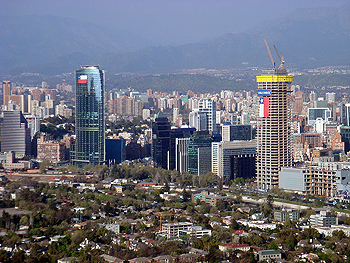On a recent flight leaving Peru, I peer out of the window, and I think about the famous Nazca Lines, a series of ancient drawings located in southern Peru. Though shaped by indigenous people centuries ago, long before hot air balloon or planes, these drawings can only been seen from the sky. I am quickly reminded that stepping back often reveals the order of seeming randomness.
It’s been a couple of years since I last visited Peru, and more than five since I had an apartment in Chile, and these gaps highlight an unmistakable trend. The center of the world is shifting from the developed to the developing world.

Last week when I visited Chile, I felt transported into Germany just 10 minutes after my car left Chile’s main airport. We were speeding through a tunnel that cut through a mountain. The smooth asphalt, high-tech toll system, and modern architecture reminded me of speeding into the Austrian Alps through German-engineered roads. The technology was beyond what we can expect to find in the United States. Chile’s economy has been growing relatively steadily at 3.7% per year for the past decade (compared to 2.9% in the U.S.) and its GDP per capita has soared from U.S. $10,000 in 2004 to $14,000 today. The country, I am told, has almost completely eradicated extreme poverty.
Speaking to a senior partner at BBDO (the accounting firm) in Peru I learned of the country’s steady momentum. It still depends on the most basic of exports—minerals and the fish powder used for animal feed—but its GDP per capita has steadily risen, nearly doubling over the past decade. With the exception of 2010, it has grown its GDP at about 8 percent over the past few years, making it one of the 30 fastest growing economies in the world. While global demand continues to raise commodity prices and thereby enrich Peru, the country is diversifying into higher-margin, value-added exports. Peruvian food is building a fan base as global as Thai food enjoys today, with restaurants appearing throughout Europe, the United States and the rest of the developing world.
Even in Bangladesh, one of the world’s poorest countries, I see a sea change underway. When I visited as I child, I remember packs of beggars that would push through the airport fences, arms reaching out for coins. Today I can walk unhindered to the car and in the streets.
A recent McKinsey study predicts that over the next decade the developing world will contribute more to global growth than the developed world, something that has not happened for 200 years. Some predict that by 2050, developed countries will have a lower share of global GDP than they did in 1700.
One of my clients—a global consumer products company—has set that “Big Hairy Audacious Goal,” to use Jim Collins’ term, of attracting 1 billion more consumers. This is only possible if one can effectively serve the emerging developing world markets successfully.
I do not think such opportunities lay only at the feet of large corporations. At a workshop I conducted for a mid-sized Internet company, we created nearly 100 growth ideas and narrowed these down to the top five. At the very top of the heap was the developing world. The team recognized it was time to start competing there.
More and more companies, and smaller and smaller ones, are coming to the same conclusion. This is why my wife now travels to China and India nearly every month and often hops onto conference calls there after putting the kids to bed.
If the opportunity seems too remote to spur you to action, consider the threat. There are more Chinese learning English than there are Americans who speak English. There is a company a lot like yours in Peru or Chile or China or Bangladesh whose fortunes are rising with their economies. They are enjoying the rise now but they are aiming over that wave, they are aiming at you, they are thinking globally.
I am willing to bet the developing world opportunity or threat is closer than you think. To find out where you stand, do the following three things:
1. List what specifically must be true for you to feel ready to enter developing markets (e.g., how big must the opportunity be, what must price levels be, what capabilities must you have?)
2. Get some data to test if each of these requirements is not already met (e.g., in my business I’ve found China pricing is already equal that of the United States)
3. Make a plan to close any gaps you have
Time is ticking.
Kaihan Krippendorf (www.kaihan.net), a founding Fellow of the Center for Leadership and an adjunct professor in the College of Business Administration, is the author of Hide a Dagger Behind a Smile and The Way of Innovation. This article was originally written as an entry for his FastCompany.com blog “The Outthinker: Mavericks that Out Innovate the Competition.” The opinions expressed in this column are the writer’s and do not necessarily reflect the views or opinions of either FIU or the College of Business Administration.
View all articles by Kaihan Krippendorff.




